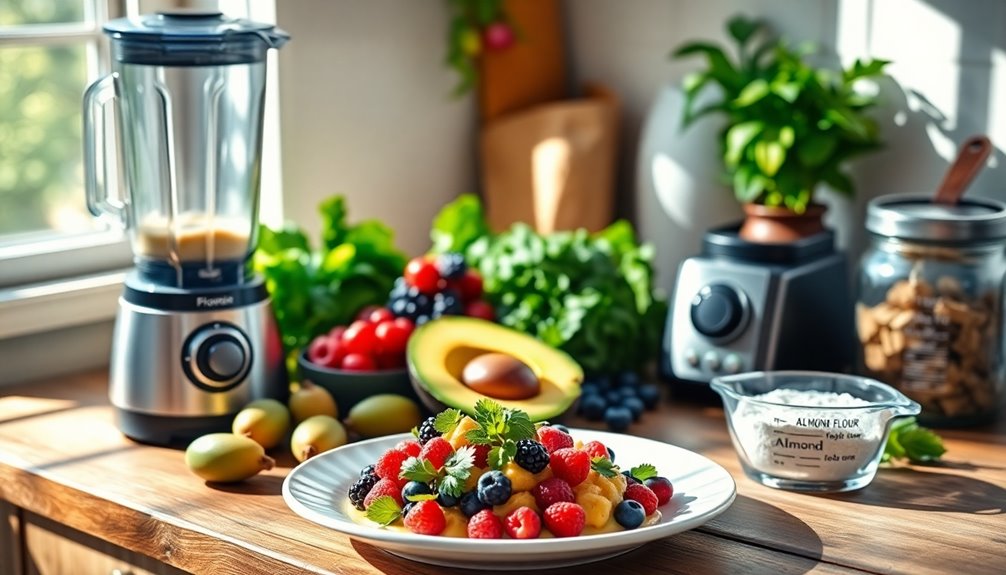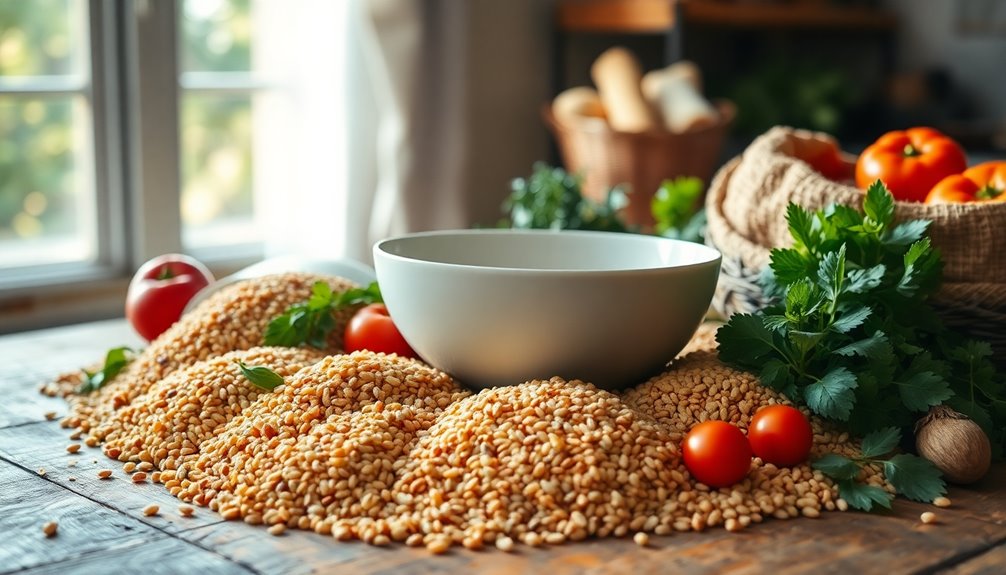To get skinny, focus on mindful eating and choose nutrient-dense foods. Pay attention to your meals; savoring each bite helps you recognize when you're full. Incorporate a variety of fruits, vegetables, and high-fiber foods to satisfy your hunger without excess calories. Stay hydrated, as drinking water can curb unnecessary snacking. Regular exercise, mixing cardio and strength training, boosts your metabolism and helps maintain weight loss. Build a supportive environment by involving friends or joining groups. By adopting these strategies, you'll set yourself up for sustainable results. There's so much more to explore about achieving your goals!
Key Takeaways
- Focus on mindful eating by savoring each bite and paying attention to hunger cues to avoid overeating.
- Prioritize nutrient-dense, whole foods while managing portion sizes to promote satiety and reduce calorie intake.
- Incorporate regular physical activity, aiming for at least 150 minutes of moderate exercise weekly to boost metabolism and support weight loss.
- Stay hydrated by drinking water before meals, which can help you feel fuller and reduce overall calorie consumption.
- Build a supportive environment by involving friends or joining groups to enhance motivation and accountability in your weight loss journey.
Mindful Eating Strategies
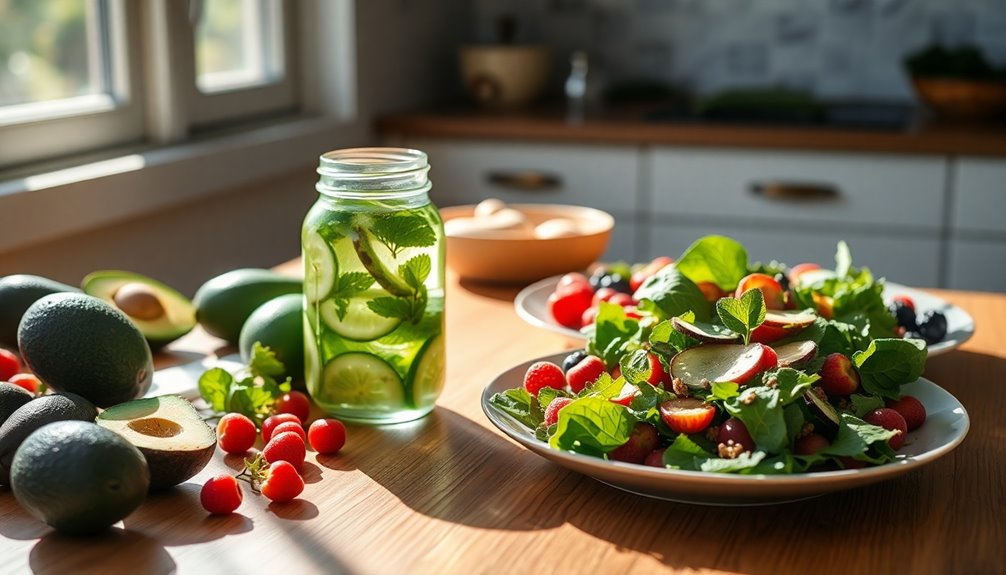
How can you transform your eating habits into a more mindful experience? Start by embracing mindful eating, which means paying full attention to your meals. This practice helps you recognize hunger and fullness cues, aiding in the reduction of overeating.
By eating slowly and savoring each bite, you allow your brain the time it needs—about 20 minutes—to register fullness. This can greatly enhance your satisfaction with meals.
Incorporate a variety of fruits and vegetables into your diet. Not only do they promote long-term healthy eating habits, but they also add flavor and nutrition without excessive calories.
As you practice mindful eating, don't hesitate to leave some food on your plate; this can help you manage your overall calorie intake while still feeling satisfied. Additionally, consider incorporating whole foods into your meals, as they can support your efforts in maintaining a balanced diet.
Importance of Nutrient-Dense Foods
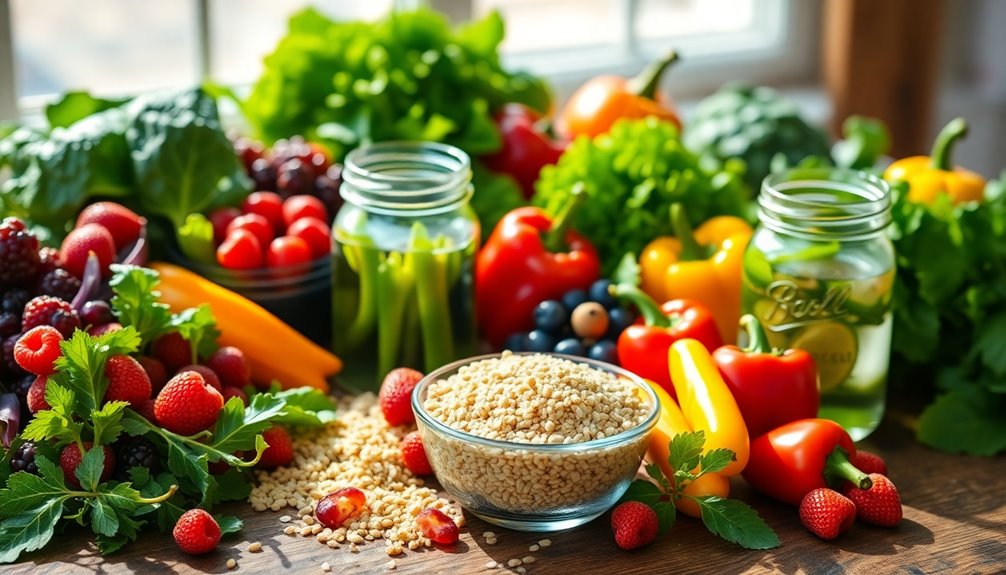
When you're aiming to get skinny, focusing on nutrient-dense food choices is essential. By incorporating low carb high protein breakfast ideas, you can ensure your meals are both satisfying and supportive of your weight loss goals.
By balancing your macronutrients and enhancing meal variety, you can boost your energy levels and keep your meals satisfying. Prioritizing these foods not only supports your weight loss journey but also contributes to your overall health. Additionally, incorporating a balanced diet rich in fruits and vegetables can further enhance your nutrient intake and promote sustainable weight loss.
Nutrient-Rich Food Choices
In your journey toward a healthier weight, focusing on nutrient-dense foods can make a significant difference.
These foods are rich in vitamins, minerals, and other essential nutrients while being lower in calories. By prioritizing nutrient-dense options, you can promote better health and support your weight loss journey. Aromatherapy can also play a role in managing stress levels, which may affect your eating habits. Additionally, incorporating chia seeds into your diet can provide a great source of dietary fiber that aids digestion and enhances satiety. Engaging in regular physical activity, such as active play, can further enhance your overall health and support your weight loss efforts. Including omega-3 fatty acids from chia seeds can also contribute to heart health and overall wellness. A diet rich in raw fruits and vegetables can also enhance nutrient intake while minimizing processed foods.
Here are some great choices to take into account:
- High-fiber carbohydrates: Incorporate whole grains and vegetables to enhance satiety, support digestive health, and regulate blood sugar levels.
- Lean proteins: Include legumes and low-fat dairy in your meals to help preserve muscle mass and increase feelings of fullness.
- Fruits and vegetables: Eat a colorful variety to guarantee you get a spectrum of nutrients and antioxidants, which can reduce the risk of chronic diseases.
- Healthy fats: Opt for sources like avocados, nuts, and olive oil, which not only provide essential nutrients but also help you manage hunger.
Balance Macronutrients Effectively
Balancing macronutrients effectively is essential to maximizing the benefits of nutrient-dense foods. To achieve weight loss and maintain energy levels, focus on creating balanced meals that include healthy fats, proteins, and high-fiber carbohydrates. These components work together to promote satiety, helping you feel full and reducing the temptation to overeat.
Incorporating a variety of whole foods like fruits, vegetables, lean proteins, and whole grains guarantees you get a broad spectrum of nutrients necessary for ideal body function. High-fiber foods, such as legumes and whole grains, are particularly effective at enhancing feelings of fullness, which can greatly lower your caloric intake. Additionally, foods like chia seeds are known for their high fiber content and can significantly aid in weight management. Including seeds in gluten-free diets can provide added protein and essential nutrients. Chia seeds, for example, are a nutrient-dense food that can boost your fiber intake and support digestive health. A juice cleanse, featuring citrus blends, can also help in detoxifying the body while supporting weight loss.
Understanding calorie density is vital when making food choices. By prioritizing lower-calorie, nutrient-rich foods over calorie-dense options, you can enjoy larger portions while still managing your weight. Additionally, incorporating herbal remedies known for their anti-aging properties can further enhance your overall health and vitality.
This approach not only supports weight loss but also contributes to overall health and well-being.
Enhance Meal Variety
Variety is the spice of life, especially when it comes to your meals. Incorporating a wide range of nutrient-dense foods not only guarantees a balanced intake of essential vitamins and minerals but also enhances your overall health.
Here are four ways to boost meal variety:
- Diverse Fruits and Vegetables: Aim for colorful plates with a mix of fruits and veggies, as they promote long-term healthy eating and enhance meal satisfaction.
- High in Fiber: Include legumes and whole grains in your diet; these foods support digestive health and create prolonged feelings of fullness, making it easier to manage portion sizes.
- Experiment with Herbs and Spices: Elevate the flavors of your healthy meals without adding extra calories. This can increase enjoyment and adherence to a nutritious diet.
- Explore New Healthy Foods: Emphasizing variety can prevent monotony and encourage you to discover new healthy foods, fostering a positive relationship with eating. Additionally, incorporating diversification in your meal planning can mirror the investment strategy of spreading resources to enhance overall health.
Effective Meal Planning Techniques
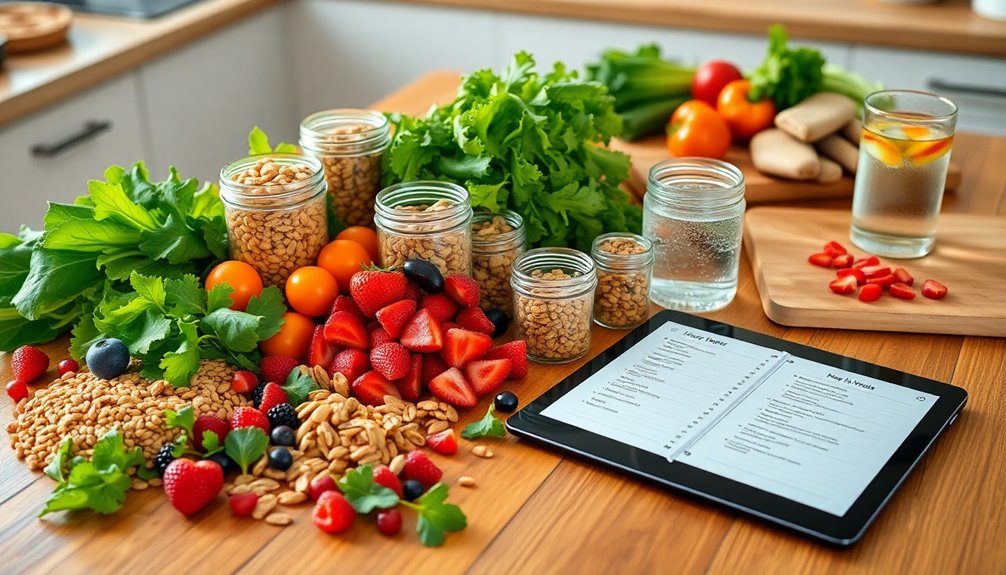
Effective meal planning techniques can transform your approach to healthy eating, making it easier to stick to your goals. Start by creating a detailed shopping list based on your meal plan. This helps streamline grocery trips and guarantees you have all the ingredients for healthy and balanced meals, while minimizing impulse purchases that can derail your progress. Additionally, incorporating content clusters in your meal planning can help you identify nutrient-rich options more effectively. Including protein-rich breakfasts like Egg Rollup and Dumpling Sauce can also set a positive tone for the day. Incorporating whole grains into your meals can provide sustained energy and contribute to overall health.
Incorporating a variety of lean proteins, whole grains, and vegetables into your plan assures nutrient-rich meals that support weight loss and overall health. Diversifying investments in your meal ingredients can ensure you're getting a broad spectrum of nutrients. Batch cooking is another valuable strategy; prepare multiple servings at once and divide them into individual containers. This promotes portion control and keeps healthy options readily available throughout the week, reducing the temptation for unhealthy snacking.
Additionally, writing down your meal plan enhances accountability, making it easier for you to adhere to your dietary goals. A consistent eating routine helps reinforce healthy habits, leading to long-term success in your weight loss journey. Moreover, implementing the "one in, one out" rule can help you manage pantry items effectively, ensuring you maintain a clutter-free kitchen that supports your healthy eating efforts.
Role of Hydration in Weight Loss

Hydration plays an essential role in your weight loss journey, often overlooked but incredibly impactful. Staying properly hydrated can help suppress your appetite, making it easier to manage hunger and reduce calorie intake.
Here are some key points to reflect on:
- Drink Water Before Meals: Consuming water before meals can promote a feeling of fullness, leading to less food consumption and lower calorie intake.
- Choose Water Over Sugary Beverages: Substituting sugary drinks with water can greatly cut down your overall caloric intake, supporting your weight loss efforts.
- Fruits and Vegetables Matter: Including high-water-content foods like fruits and vegetables not only hydrates you but also helps you feel satisfied, making it easier to control your appetite.
- Thirst vs. Hunger: Staying hydrated helps distinguish between thirst and hunger, preventing unnecessary snacking and aiding in effective weight management.
Incorporating these hydration strategies not only supports your weight loss goals but also enhances your overall health.
Exercise and Physical Activity Tips

Exercise is a key component of any successful weight loss strategy, and it doesn't have to be overwhelming. Aim for at least 150 minutes of moderate-intensity aerobic exercise each week—think brisk walking or cycling. Adding strength training at least two days a week not only helps build muscle but also boosts your metabolism, enhancing calorie burn even at rest. Engaging in regular exercise can also contribute to your overall mental wellbeing, fostering emotional resilience and aiding in coping with challenges. Additionally, incorporating visualization techniques can enhance your motivation and focus on achieving fitness goals. Regular physical activity can also improve your indoor air quality, as clean air from devices like HEPA filters can promote better respiratory health during workouts. Moreover, maintaining clean indoor air through the use of air purifiers can further support your exercise performance and recovery.
Consider incorporating interval training, where you alternate between high-intensity bursts and lower-intensity recovery periods. This method maximizes calorie burn and improves cardiovascular fitness efficiently.
Don't forget about small lifestyle changes! Simple actions like taking the stairs instead of the elevator or walking during breaks can greatly increase your daily activity levels. Consistency is essential; regular exercise supports weight loss and improves your mood, energy levels, and overall health. Additionally, maintaining an adequate hydration level is crucial for optimizing your physical performance and aiding in weight loss.
Here's a quick reference table for your exercise routine:
| Activity Type | Frequency |
|---|---|
| Moderate-Intensity | 150 minutes/week |
| Strength Training | 2 days/week |
| Interval Training | 1-2 days/week |
| Small Lifestyle Changes | Daily (as opportunities arise) |
Building a Supportive Environment

Creating a supportive environment can considerably enhance your weight loss journey. Surrounding yourself with the right people and resources fosters motivation and accountability, making it easier to stick to your eating habits.
Here are four effective ways to build a supportive environment:
- Join a Weight Loss Group: Engage in a local or online group where you can share experiences. Studies show that group participation leads to the best weight loss outcomes.
- Involve Friends and Family: Share your goals with loved ones. Their encouragement can considerably enhance your adherence to dietary plans and workout routines.
- Seek Professional Guidance: Consult with nutritionists or dietitians to tailor your weight loss strategy. Personalized advice increases the chances of sustainable weight loss.
- Create Healthy Social Circles: Surround yourself with peers who prioritize healthy habits. Your social circles can considerably influence dietary choices and physical activity levels.
Frequently Asked Questions
What Is the Biggest Secret to Losing Weight?
The biggest secret to losing weight lies in understanding your food choices.
Focus on incorporating lower calorie density foods, like fruits and veggies, into your meals. Establish consistent eating patterns to avoid extreme hunger, and prioritize high-protein options to keep you full longer.
Practice mindful eating by savoring each bite and tuning into your hunger cues. Don't forget to stay hydrated; sometimes, thirst feels like hunger, leading to unnecessary snacking.
What Drink Burns the Most Belly Fat?
Isn't it ironic how the simplest drinks can pack a punch against belly fat?
You'll find that drinking water before meals helps curb your appetite, while green tea boosts fat oxidation.
Apple cider vinegar improves insulin sensitivity, and lemon juice adds hydration with a side of fullness.
Herbal teas like ginger or peppermint can ease digestion, reducing bloating.
What Is the 3-3-3 Rule for Weight Loss?
The 3-3-3 rule for weight loss focuses on eating three balanced meals a day.
Each meal should include three components: a source of protein, healthy fats, and high-fiber carbohydrates.
Aim for at least 20-30 grams of protein per meal to keep you full and support muscle preservation.
This approach helps stabilize blood sugar levels and encourages mindful eating, making it easier to control portions and recognize your hunger and fullness signals.
What's the Secret to Being Skinny?
The secret to being skinny lies in adopting healthy habits.
You've gotta practice mindful eating, paying attention to your hunger cues and savoring each bite. Incorporate a balance of macronutrients in your meals to keep you satisfied and energized.
Planning your meals ahead can prevent impulsive choices. Eating smaller, frequent meals helps control your appetite, and staying hydrated supports your metabolism.
Make these changes, and you'll find it easier to reach your goals.
Conclusion
As you commence your journey to get skinny, think of yourself as a gardener nurturing a vibrant garden. Each mindful meal, like a seed planted with care, grows into a healthy habit. Hydration acts as the rain, nourishing your efforts, while exercise becomes the sunlight, energizing your progress. Surround yourself with supportive friends, like sturdy trellises that help you reach new heights. Remember, the path to health is a beautiful landscape, and you're the one cultivating it.

